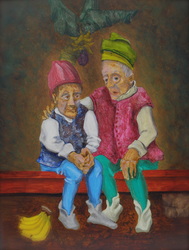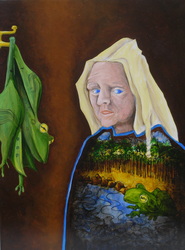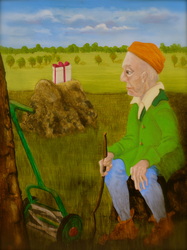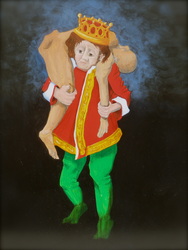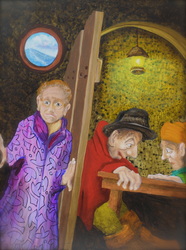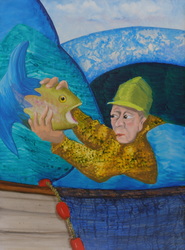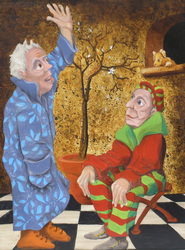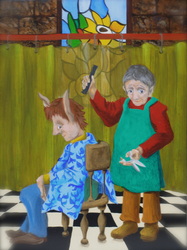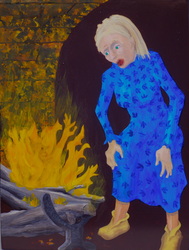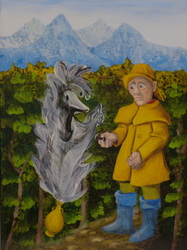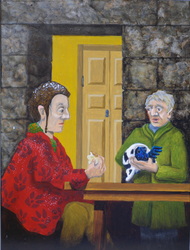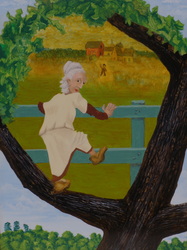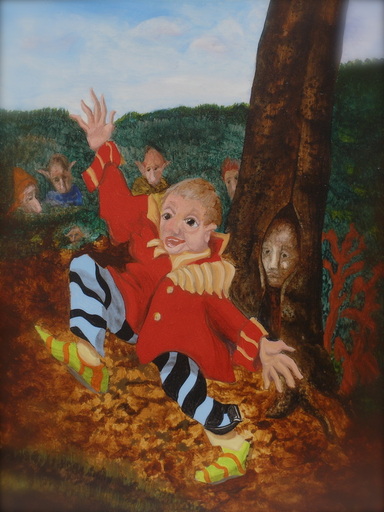 The Old Man Who Lost His Wen, 8" x 6", Oil on wood, 2013
The Old Man Who Lost His Wen, 8" x 6", Oil on wood, 2013
The Old Man Who Lost His Wen
Synopsis by William Disbro, created from: In The Ever After by Allan Chinen, (pp 75-83)
As a youth without blemish, a mature adult has had to deal with a wen on his face. After unsuccessful attempts to remove the wen he learns to accept its disfigurement as a part of his life. A demon-king watched the old man dance and needed a guarantee the old man would return the next day and teach the demons to dance, and, having nothing of value on him, the king plucked the wen from his face as a pledge to return. Upon hearing of this story an evil neighbor, also with a large wen on his face, decided to go in place of the dancer so his wen could be removed. The demons were horrified at this man’s inability to dance and the demon-king threw the pledged wen at the man and it stuck on the other side of his face. He returned home with two wens and spent the rest of his life hiding under a large hat.
Dr. Chinen: The old man had developed a skill and enjoyed showing it to others. He was a serious dancer who shared his abilities. “Elder Tales suggest that the restoration of innocence is a major task in later life.” (p 80) “… in emancipating himself from social convention, the old man does not eliminate adult rationality. He adds spontaneity and innocence to mature judgment and skill.” (p 80)
Synopsis by William Disbro, created from: In The Ever After by Allan Chinen, (pp 75-83)
As a youth without blemish, a mature adult has had to deal with a wen on his face. After unsuccessful attempts to remove the wen he learns to accept its disfigurement as a part of his life. A demon-king watched the old man dance and needed a guarantee the old man would return the next day and teach the demons to dance, and, having nothing of value on him, the king plucked the wen from his face as a pledge to return. Upon hearing of this story an evil neighbor, also with a large wen on his face, decided to go in place of the dancer so his wen could be removed. The demons were horrified at this man’s inability to dance and the demon-king threw the pledged wen at the man and it stuck on the other side of his face. He returned home with two wens and spent the rest of his life hiding under a large hat.
Dr. Chinen: The old man had developed a skill and enjoyed showing it to others. He was a serious dancer who shared his abilities. “Elder Tales suggest that the restoration of innocence is a major task in later life.” (p 80) “… in emancipating himself from social convention, the old man does not eliminate adult rationality. He adds spontaneity and innocence to mature judgment and skill.” (p 80)
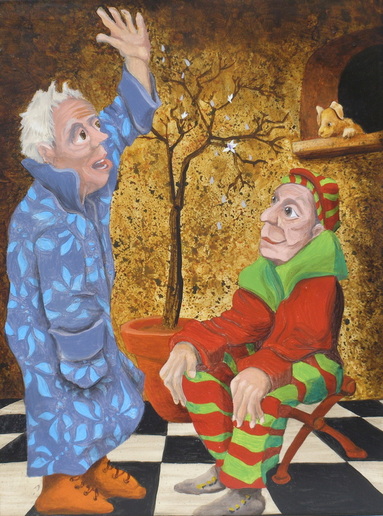 The Old Man Who Made Withered Trees Flower,
8" x 6", Oil on wood, 2013
The Old Man Who Made Withered Trees Flower,
8" x 6", Oil on wood, 2013
The Old Man Who Made Withered Trees Flower
Synopsis by William Disbro, created from: In The Ever After by Allan Chinen, (pp 129-137)
A childless couple loved their dog and one day the barking at a particular spot of ground got the old man to dig – and he uncovered a sack of gold coins. The greedy neighbor borrowed the dog so it could find gold for him. The dog was unsuccessful and the neighbor killed it. The dog’s owner carved a mortar and pestle from the tree that stood over the dog’s grave. The mortar produced delicious food for the elder couple and the neighbor borrowed it to produce food for him but it only produced foul wastes so he burned it. The owner arrived to claim his mortar/pestle but could only return home with it’s ashes. But he learned that when those ashes touched barren branches the branches bloomed – even in winter. He demonstrated grand results for the Sultan
and the next day the evil neighbor tried to show what he could do with his ashes. Nothing happened except to cover the Sultan and his court with ashes. The neighbor spent the remainder of his life in prison.
Dr. Chinen writes of the symbolism in the theme of reclaiming the magic and wonder of childhood. At the end of life one returns to the beginning with experiences being transfigured and illuminated. (p. 132) The dog, gold coins, greedy neighbor, mortar, ashes and blossoms are all symbols for the human cycle of oral, anal, phallic and genital stages that reverse in old age.
Synopsis by William Disbro, created from: In The Ever After by Allan Chinen, (pp 129-137)
A childless couple loved their dog and one day the barking at a particular spot of ground got the old man to dig – and he uncovered a sack of gold coins. The greedy neighbor borrowed the dog so it could find gold for him. The dog was unsuccessful and the neighbor killed it. The dog’s owner carved a mortar and pestle from the tree that stood over the dog’s grave. The mortar produced delicious food for the elder couple and the neighbor borrowed it to produce food for him but it only produced foul wastes so he burned it. The owner arrived to claim his mortar/pestle but could only return home with it’s ashes. But he learned that when those ashes touched barren branches the branches bloomed – even in winter. He demonstrated grand results for the Sultan
and the next day the evil neighbor tried to show what he could do with his ashes. Nothing happened except to cover the Sultan and his court with ashes. The neighbor spent the remainder of his life in prison.
Dr. Chinen writes of the symbolism in the theme of reclaiming the magic and wonder of childhood. At the end of life one returns to the beginning with experiences being transfigured and illuminated. (p. 132) The dog, gold coins, greedy neighbor, mortar, ashes and blossoms are all symbols for the human cycle of oral, anal, phallic and genital stages that reverse in old age.
 The Old Alchemist, 8" x 6", Oil on wood, 2013
The Old Alchemist, 8" x 6", Oil on wood, 2013
The Old Alchemist
Synopsis by William Disbro, created from: In The Ever After by Allan Chinen, Chiron Publications, 1989.
The theme is wisdom and Dr. Chinen writes about five incredible pages explaining the symbolism in this tale.
The daughter’s husband neglects everything as he searches for the secret to produce gold. Things are desperate when the daughter asks her father to speak to his son-in-law. The husband meets the father expecting to be severely chastised. The father confides that he too spent his youth searching for the secret, and at last he found it. In great excitement the son-in-law asks how it is done. You need two pounds of the silver dust found only on banana leaves but such an arduous task is now beyond me, the father said. Plans were immediately made to start growing banana trees. The father even gave some money to help purchase land and trees.
For two years the son-in-law toiled ceaselessly to plant more and more trees and gather the precious silver dust. At last he had the two pounds and he met with the father to find out how to convert to gold. The father asked his daughter what she had done with all the bananas and she said she had taken them to market each day. When asked what she did with the money from sales she replied that was the money they lived on. And asked if there was any extra she showed her father a small sack of gold coins. The father picked up a handful of dirt and held it out to his son-in-law and with the other hand held out the gold coins. From this to this, he said. And the son-in-law saw the wisdom of his efforts with the banana trees and resolved to work even harder to grow bananas.
Synopsis by William Disbro, created from: In The Ever After by Allan Chinen, Chiron Publications, 1989.
The theme is wisdom and Dr. Chinen writes about five incredible pages explaining the symbolism in this tale.
The daughter’s husband neglects everything as he searches for the secret to produce gold. Things are desperate when the daughter asks her father to speak to his son-in-law. The husband meets the father expecting to be severely chastised. The father confides that he too spent his youth searching for the secret, and at last he found it. In great excitement the son-in-law asks how it is done. You need two pounds of the silver dust found only on banana leaves but such an arduous task is now beyond me, the father said. Plans were immediately made to start growing banana trees. The father even gave some money to help purchase land and trees.
For two years the son-in-law toiled ceaselessly to plant more and more trees and gather the precious silver dust. At last he had the two pounds and he met with the father to find out how to convert to gold. The father asked his daughter what she had done with all the bananas and she said she had taken them to market each day. When asked what she did with the money from sales she replied that was the money they lived on. And asked if there was any extra she showed her father a small sack of gold coins. The father picked up a handful of dirt and held it out to his son-in-law and with the other hand held out the gold coins. From this to this, he said. And the son-in-law saw the wisdom of his efforts with the banana trees and resolved to work even harder to grow bananas.
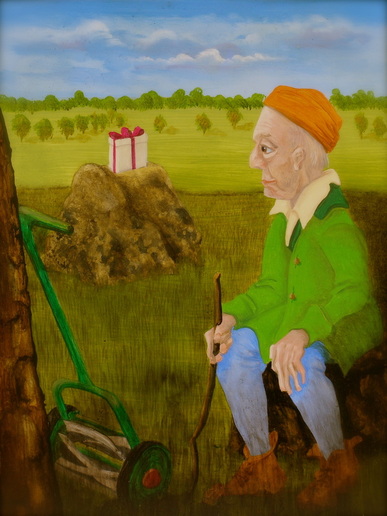 The Simple Grasscutter, 8" x 6", Oil on wood, 2013
The Simple Grasscutter, 8" x 6", Oil on wood, 2013
The Simple Grasscutter
Synopsis by William Disbro, created from: In The Ever After by Allan Chinen, (pp 85-93)
An old man without wife or family had worked hard throughout his life and wished to share some of his savings so he bought a gold bracelet and had it delivered anonymously to whom he was told was the most beautiful and virtuous woman. Perplexed by the anonymity but in gratitude she returned a greater gift. The old man didn’t need or want the gift so he had it delivered anonymously to the most handsome and virtuous man. The man returned an even greater gift to the old man. Again, the new gift was delivered to the woman and an even greater gift was returned only to be passed on to the young man. Eventually, the mother and father of the princess became involved and they seek the identity of the donor. The old man is terrified to host the King and Queen and contemplates suicide but two angels intervene and they furnish a palace with servants and food for a grand reception. The King grants marriage of his daughter to the old man but he declines as being too old but he suggests the young prince in his place who had been receiving the princess’s gifts. So the young couple was married, the King and Queen were happy and the old man could still cut grass as he wished.
Dr. Chinen writes about generativity in this tale but it is joined by the equally major task of the development of integrity. (p 90) The old man has many chances to change his life but he knew who he was and did not compare his life to others or ask unanswerable questions such as what if I did …? He surrendered his pride when he collapsed and then the angels came to reward with psychological wealth. (p 93)
Synopsis by William Disbro, created from: In The Ever After by Allan Chinen, (pp 85-93)
An old man without wife or family had worked hard throughout his life and wished to share some of his savings so he bought a gold bracelet and had it delivered anonymously to whom he was told was the most beautiful and virtuous woman. Perplexed by the anonymity but in gratitude she returned a greater gift. The old man didn’t need or want the gift so he had it delivered anonymously to the most handsome and virtuous man. The man returned an even greater gift to the old man. Again, the new gift was delivered to the woman and an even greater gift was returned only to be passed on to the young man. Eventually, the mother and father of the princess became involved and they seek the identity of the donor. The old man is terrified to host the King and Queen and contemplates suicide but two angels intervene and they furnish a palace with servants and food for a grand reception. The King grants marriage of his daughter to the old man but he declines as being too old but he suggests the young prince in his place who had been receiving the princess’s gifts. So the young couple was married, the King and Queen were happy and the old man could still cut grass as he wished.
Dr. Chinen writes about generativity in this tale but it is joined by the equally major task of the development of integrity. (p 90) The old man has many chances to change his life but he knew who he was and did not compare his life to others or ask unanswerable questions such as what if I did …? He surrendered his pride when he collapsed and then the angels came to reward with psychological wealth. (p 93)
 Frog Mother, from: The Widow and the Frog,
8" x 6", Oil on wood, 2013
Frog Mother, from: The Widow and the Frog,
8" x 6", Oil on wood, 2013
The Widow and the Frog
Synopsis by William Disbro, created from: In The Ever After by Allan Chinen, (pp 105-113)
This is a complicated tale full of symbolism in which an elderly widow reluctantly agrees to become a mother to a speaking frog. The frog brings positive changes to the widow’s life and then seeks a bride for himself. After gaining a bride the frog, along with his wife and mother, set out to watch a tournament but the frog excuses himself to do a chore. A handsome stranger wins all the events in town and then the same events are repeated the next day. On the third day wife and mother become suspicious of their frog and they secretly return home to find a frog suit hanging in the house. The mother and wife burn the frog suit as the handsome stranger returns home. He explains he is a magical being but aren’t we all the same under our skin?
Dr. Chinen suggests the relationships between the old woman and the frog symbolize the ideal role the elder plays with respect to youth. (p. 110) Transcendent inspiration must be integrated with worldly abilities and the mediating role of the elder is a developmental task, not merely an inevitable effect of aging. (pp. 112-113)
Synopsis by William Disbro, created from: In The Ever After by Allan Chinen, (pp 105-113)
This is a complicated tale full of symbolism in which an elderly widow reluctantly agrees to become a mother to a speaking frog. The frog brings positive changes to the widow’s life and then seeks a bride for himself. After gaining a bride the frog, along with his wife and mother, set out to watch a tournament but the frog excuses himself to do a chore. A handsome stranger wins all the events in town and then the same events are repeated the next day. On the third day wife and mother become suspicious of their frog and they secretly return home to find a frog suit hanging in the house. The mother and wife burn the frog suit as the handsome stranger returns home. He explains he is a magical being but aren’t we all the same under our skin?
Dr. Chinen suggests the relationships between the old woman and the frog symbolize the ideal role the elder plays with respect to youth. (p. 110) Transcendent inspiration must be integrated with worldly abilities and the mediating role of the elder is a developmental task, not merely an inevitable effect of aging. (pp. 112-113)
 The King and the Ghoul, 8" x 6", Oil on wood, 2013
The King and the Ghoul, 8" x 6", Oil on wood, 2013
The King and the Ghoul
Synopsis by William Disbro, created from: Beyond the Hero by Allan Chinen, (pp 92-113)
A king is enticed to help a “sage” in a cemetery ritual. But his task seems impossible as each time he tries to carry the corpse across the grave yard a ghoul whispers a riddle in his ear. A correct response starts the journey all over again and an incorrect answer means the king will die. A no-win situation until the last riddle that stumps the king. His no response elicits a warning from the ghoul that the “sage” is really a necromancer who is planning to kill the king. The king is told how to kill the necromancer. And he did. Then a thousand spirits materialized and praised the king. Shiva asked what the king would wish for and he replied that the stories told to him this night could be told to all men.
Dr. Chinen explains that the Trickster appears as the ghoul offering riddles in the king’s ear. The riddles are symbolic of what must be learned and developed on the path to elder enlightenment.
Synopsis by William Disbro, created from: Beyond the Hero by Allan Chinen, (pp 92-113)
A king is enticed to help a “sage” in a cemetery ritual. But his task seems impossible as each time he tries to carry the corpse across the grave yard a ghoul whispers a riddle in his ear. A correct response starts the journey all over again and an incorrect answer means the king will die. A no-win situation until the last riddle that stumps the king. His no response elicits a warning from the ghoul that the “sage” is really a necromancer who is planning to kill the king. The king is told how to kill the necromancer. And he did. Then a thousand spirits materialized and praised the king. Shiva asked what the king would wish for and he replied that the stories told to him this night could be told to all men.
Dr. Chinen explains that the Trickster appears as the ghoul offering riddles in the king’s ear. The riddles are symbolic of what must be learned and developed on the path to elder enlightenment.
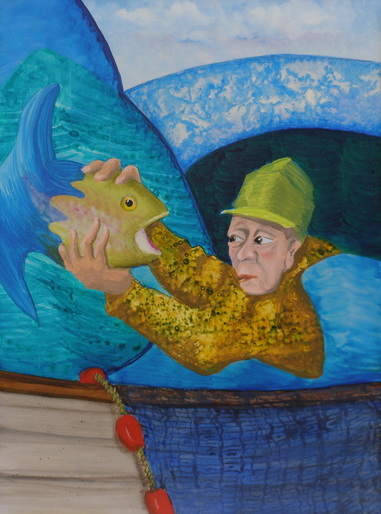 The Dragon King of the Sea, 8"x 6", Oil on wood,
2013
The Dragon King of the Sea, 8"x 6", Oil on wood,
2013
The Dragon King of the Sea
Synopsis by William Disbro, created from: In The Ever After by Allan Chinen, (pp 65-74)
After not catching a fish all day the old fisherman catches a huge one but looking into its eye the fisherman took pity and let it go. As a reward for not killing his son the Sea King gives a magic cup to the fisherman. All goes well until an evil couple steals the cup. But the fisherman’s dog and cat scheme to regain the cup and they are successful. But in swimming across a river the dog asks the cat sitting on top of him if she still has the cup. The cat finally answers and in so doing drops the cup into the river. After much searching the cat only finds a dead fish on the river bank and takes it home for the fisherman’s wife to clean. The wife finds the cup in the stomach of the fish.
Dr. Chinen explains the fisherman’s self-transcendence is introspective and psychological. In youth heroic ideals and lofty visions give way to a maturity that helps adults transcend the self, not find it.
Synopsis by William Disbro, created from: In The Ever After by Allan Chinen, (pp 65-74)
After not catching a fish all day the old fisherman catches a huge one but looking into its eye the fisherman took pity and let it go. As a reward for not killing his son the Sea King gives a magic cup to the fisherman. All goes well until an evil couple steals the cup. But the fisherman’s dog and cat scheme to regain the cup and they are successful. But in swimming across a river the dog asks the cat sitting on top of him if she still has the cup. The cat finally answers and in so doing drops the cup into the river. After much searching the cat only finds a dead fish on the river bank and takes it home for the fisherman’s wife to clean. The wife finds the cup in the stomach of the fish.
Dr. Chinen explains the fisherman’s self-transcendence is introspective and psychological. In youth heroic ideals and lofty visions give way to a maturity that helps adults transcend the self, not find it.
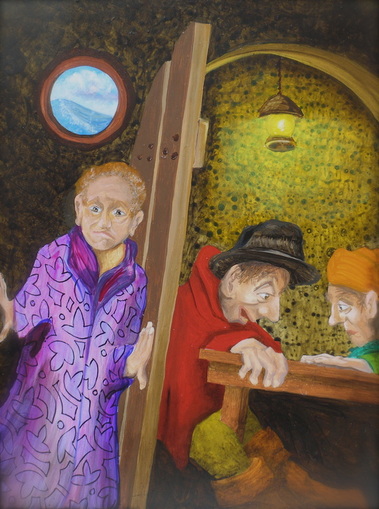 Overheard, from: The Wise Merchant, 8" x 6", Oil on wood, 2013
Overheard, from: The Wise Merchant, 8" x 6", Oil on wood, 2013
The Wise Merchant
Synopsis by William Disbro, created from: In The Ever After by Allan Chinen, Chiron Publications, 1989. (pp 39-43)
A father and son set out on a sea voyage with a chest filled with all their treasure. After overhearing a plot to kill them to gain the treasure the father and son stage an argument on deck over the treasure. They open the chest to show all the gold and jewels during the argument and the father lifts the chest over the railing and dumps chest and all into the sea. The seamen are incredulous.
When the voyage ended the father went to the local magistrate and had the sailors arrested for piracy and attempted murder. The judge asked the sailors if they had seen the old man throw his treasure overboard – and they all agreed. The judge convicted them all, for: “What man would throw away his life’s savings, except if he feared for his life?” The pirates replaced the merchant’s jewels in return for the judge sparring their lives.
The elder merchant’s wisdom depends on his knowledge of human evil and the motivation of human greed but he also must be able to master his own covetousness as in being able to throw his treasure overboard. Mastery of one’s own evil is a prerequisite of wisdom.
Synopsis by William Disbro, created from: In The Ever After by Allan Chinen, Chiron Publications, 1989. (pp 39-43)
A father and son set out on a sea voyage with a chest filled with all their treasure. After overhearing a plot to kill them to gain the treasure the father and son stage an argument on deck over the treasure. They open the chest to show all the gold and jewels during the argument and the father lifts the chest over the railing and dumps chest and all into the sea. The seamen are incredulous.
When the voyage ended the father went to the local magistrate and had the sailors arrested for piracy and attempted murder. The judge asked the sailors if they had seen the old man throw his treasure overboard – and they all agreed. The judge convicted them all, for: “What man would throw away his life’s savings, except if he feared for his life?” The pirates replaced the merchant’s jewels in return for the judge sparring their lives.
The elder merchant’s wisdom depends on his knowledge of human evil and the motivation of human greed but he also must be able to master his own covetousness as in being able to throw his treasure overboard. Mastery of one’s own evil is a prerequisite of wisdom.
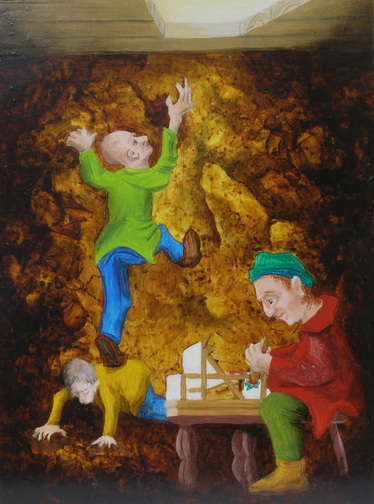 The Loom, from: The Sultan's Handkerchief,
8" x 6", Oil on wood, 2013
The Loom, from: The Sultan's Handkerchief,
8" x 6", Oil on wood, 2013
The Loom From: The Sultan’s Handkerchief: Men’s Initiation into the Feminine
Synopsis by William Disbro, created from: Beyond the Hero: Classic Stories of Men in Search of Soul, by Allan B. Chinen, originally published by Jeremy Tarcher/Putnam Books, 1993.
Dr. Chinen’s explanation of the symbolism involved in this tale is fascinating and enlightening as men venture beyond the hero and reclaim their own feminine side as a preliminary task for men at mid-life. (The cannibal-cook personifies the shadow in men’s lives.)
The Sultan wanted to learn to weave and after practice he wove his fiancée a beautiful handkerchief of a particular red rose and background. The Sultan wanted to see what his people really thought of him and so he and two aides went to town in disguise and while there they became hungry and went into a famous restaurant where they fell into a deep pit. The restaurant owner/butcher looked down at them and welcomed them for slaughter to add to the menu. First terror and then thinking lead the disguised Sultan to request a loom in place of being slaughtered so that fine goods could be made and sold at the Sultan’s court. A loom was lowered down. The Sultan wove an exact copy of his rose handkerchief that he had given to his fiancée who was now queen. The Sultan told the butcher to take the handkerchief to the Sultan’s court and he would be given a great amount of money for it. When the Queen saw the handkerchief she had the butcher followed and the Sultan and his aides were rescued.
Synopsis by William Disbro, created from: Beyond the Hero: Classic Stories of Men in Search of Soul, by Allan B. Chinen, originally published by Jeremy Tarcher/Putnam Books, 1993.
Dr. Chinen’s explanation of the symbolism involved in this tale is fascinating and enlightening as men venture beyond the hero and reclaim their own feminine side as a preliminary task for men at mid-life. (The cannibal-cook personifies the shadow in men’s lives.)
The Sultan wanted to learn to weave and after practice he wove his fiancée a beautiful handkerchief of a particular red rose and background. The Sultan wanted to see what his people really thought of him and so he and two aides went to town in disguise and while there they became hungry and went into a famous restaurant where they fell into a deep pit. The restaurant owner/butcher looked down at them and welcomed them for slaughter to add to the menu. First terror and then thinking lead the disguised Sultan to request a loom in place of being slaughtered so that fine goods could be made and sold at the Sultan’s court. A loom was lowered down. The Sultan wove an exact copy of his rose handkerchief that he had given to his fiancée who was now queen. The Sultan told the butcher to take the handkerchief to the Sultan’s court and he would be given a great amount of money for it. When the Queen saw the handkerchief she had the butcher followed and the Sultan and his aides were rescued.
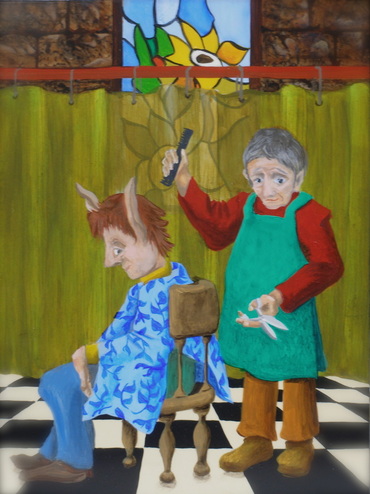 The Barber, from: The King's Ears, 8" x 6", Oil on wood, 2013
The Barber, from: The King's Ears, 8" x 6", Oil on wood, 2013
The King’s Ears: The Shadow of the Patriarch
Synopsis by William Disbro, created from: Beyond the Hero: Classic Stories of Men in Search of Soul, by Allan B. Chinen, originally published by Jeremy Tarcher/Putnam Books, 1993.
A mighty king had goat ears and hid them in his crown but whenever he had a haircut the barber discovered the secret. When asked how he looked after the haircut the barbers always replied: “handsome, except for the goat’s ears.” And the king always killed the barber to keep the secret.
Then a young barber, after the haircut, decided not to mention the ears and he was rewarded with gold but after awhile he became wasted away from the secret he held inside. He was told to dig a deep hole in the woods and shout out the secret into the hole. He did this and reeds grew on that spot of earth. One day children cut the reeds to make flutes and as they blew on them out came the words: “The King has goat ears.” Soon the whole community heard about this and the king confronted his barber: “How dare you reveal my secret! Prepare to die!” But the barber explained he had told no one and told of the hole in the earth and the king traveled to the reeds and cut his own flute and blew on it. The words “The King has goat ears!” came flowing through the reed. The children’s stories were true and even the earth knew of the king’s secret. The king smiled and was relieved his secret was out. Everyone could laugh at his ears and still obey his laws.
Dr. Chinen carefully explains the symbolism involving shame carried by an older powerful man being saved by a young man who is a player in getting the king to confront his shame. The hair that must be cut, the goat’s ears, the hole dug into the earth relate to wildness that stand as alternatives to the patriarchal ideal of manhood. Are alternatives helpful? Necessary? How much influence of the wildness is necessary, or acceptable?
Synopsis by William Disbro, created from: Beyond the Hero: Classic Stories of Men in Search of Soul, by Allan B. Chinen, originally published by Jeremy Tarcher/Putnam Books, 1993.
A mighty king had goat ears and hid them in his crown but whenever he had a haircut the barber discovered the secret. When asked how he looked after the haircut the barbers always replied: “handsome, except for the goat’s ears.” And the king always killed the barber to keep the secret.
Then a young barber, after the haircut, decided not to mention the ears and he was rewarded with gold but after awhile he became wasted away from the secret he held inside. He was told to dig a deep hole in the woods and shout out the secret into the hole. He did this and reeds grew on that spot of earth. One day children cut the reeds to make flutes and as they blew on them out came the words: “The King has goat ears.” Soon the whole community heard about this and the king confronted his barber: “How dare you reveal my secret! Prepare to die!” But the barber explained he had told no one and told of the hole in the earth and the king traveled to the reeds and cut his own flute and blew on it. The words “The King has goat ears!” came flowing through the reed. The children’s stories were true and even the earth knew of the king’s secret. The king smiled and was relieved his secret was out. Everyone could laugh at his ears and still obey his laws.
Dr. Chinen carefully explains the symbolism involving shame carried by an older powerful man being saved by a young man who is a player in getting the king to confront his shame. The hair that must be cut, the goat’s ears, the hole dug into the earth relate to wildness that stand as alternatives to the patriarchal ideal of manhood. Are alternatives helpful? Necessary? How much influence of the wildness is necessary, or acceptable?
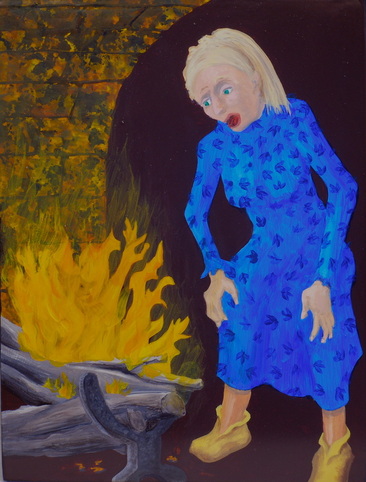 Something in the Fire, from: The Magic Forest, 8" x 6", oil on wood, 2013.
Something in the Fire, from: The Magic Forest, 8" x 6", oil on wood, 2013.
Something in the Fire from: The Magic Forest
Synopsis by William Disbro, created from: In The Ever After by Allan Chinen, (pp 45-56)
A son and his new wife lived with his mother and the wife was mean and demanding with the mother because the mother knew that the wife had a forked tongue and was really a snake. While despairing, the mother helped a young girl who in turn sent elves to help the mother. The wife was finally revealed to be a snake but the son was still bewitched and he banished his mother from the house. The Forest-King gave the mother the option of returning to her young life with her new husband but when the mother found out that she would no longer have her son she rejected the offer. At that moment the spell was broken and the snake-wife slithered into a hole and the son re-united with his mother. Dr. Chinen writes of the necessity of self-transcendence for the mother’s success. The mother’s altruism benefits all of society. The generativity shown by the mother does indeed go beyond her own self-interest.
Synopsis by William Disbro, created from: In The Ever After by Allan Chinen, (pp 45-56)
A son and his new wife lived with his mother and the wife was mean and demanding with the mother because the mother knew that the wife had a forked tongue and was really a snake. While despairing, the mother helped a young girl who in turn sent elves to help the mother. The wife was finally revealed to be a snake but the son was still bewitched and he banished his mother from the house. The Forest-King gave the mother the option of returning to her young life with her new husband but when the mother found out that she would no longer have her son she rejected the offer. At that moment the spell was broken and the snake-wife slithered into a hole and the son re-united with his mother. Dr. Chinen writes of the necessity of self-transcendence for the mother’s success. The mother’s altruism benefits all of society. The generativity shown by the mother does indeed go beyond her own self-interest.
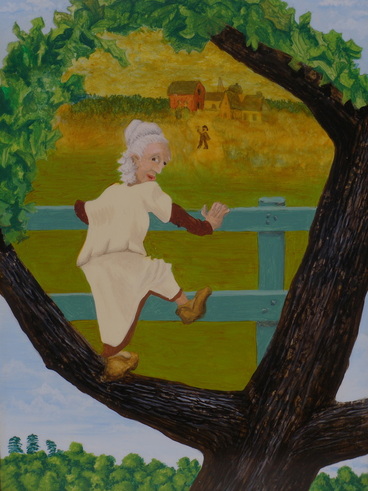 What Will Happen To My Son? from: The Magic Forest, 8" x 6", oil on wood, 2013.
What Will Happen To My Son? from: The Magic Forest, 8" x 6", oil on wood, 2013.
What Will Happen To My Son? from: The Magic Forest
Synopsis by William Disbro, created from: In The Ever After by Allan Chinen, (pp 45-56)
A son and his new wife lived with his mother and the wife was mean and demanding with the mother because the mother knew that the wife had a forked tongue and was really a snake. While despairing, the mother helped a young girl who in turn sent elves to help the mother. The wife was finally revealed to be a snake but the son was still bewitched and he banished his mother from the house. The Forest-King gave the mother the option of returning to her young life with her new husband but when the mother found out that she would no longer have her son she rejected the offer. At that moment the spell was broken and the snake-wife slithered into a hole and the son re-united with his mother. Dr. Chinen writes of the necessity of self-transcendence for the mother’s success. The mother’s altruism benefits all of society. The generativity shown by the mother does indeed go beyond her own self-interest.
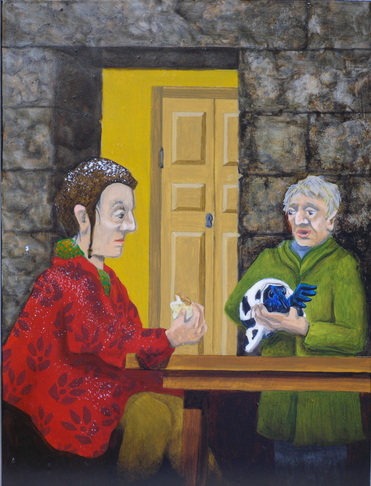 The Little Peasant, 8" x 6", oil on wood, 2013.
The Little Peasant, 8" x 6", oil on wood, 2013.
The Little Peasant
The little peasant is a con man who fools a cowherd into exchanging a real cow for a wooden calf, dupes the miller into paying 300 gold coins for a “prophesy” and latter tricks the shepherd into being executed in his place.
In this complicated tale Dr. Chinen describes the symbols dealing with two traits: resorting to trickery out of necessity and not denying responsibility for one’s actions. These are characteristics of tricksters across cultures.
Synopsis by William Disbro, created from: In The Ever After by Allan Chinen,
(pp 71-91).
The little peasant is a con man who fools a cowherd into exchanging a real cow for a wooden calf, dupes the miller into paying 300 gold coins for a “prophesy” and latter tricks the shepherd into being executed in his place.
In this complicated tale Dr. Chinen describes the symbols dealing with two traits: resorting to trickery out of necessity and not denying responsibility for one’s actions. These are characteristics of tricksters across cultures.
Synopsis by William Disbro, created from: In The Ever After by Allan Chinen,
(pp 71-91).
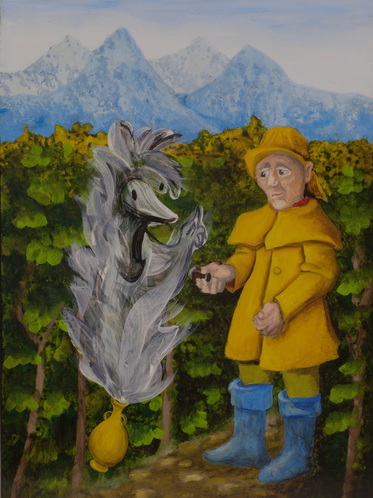 The Fisherman and the Djinn, 8" x 6", oil on wood, 2013.
The Fisherman and the Djinn, 8" x 6", oil on wood, 2013.
The Fisherman and the Djinn
A fisherman releases a djinn from a bottle he has netted and has to trick him not to kill him and finally gets the djinn back into the bottle. After much story-telling between fisherman and djinn the djinn is released and shows the fisherman where to catch special fish that must be taken to the Sultan. The Sultan gets involved when the magic fish events lead him to a gloomy castle with an imprisoned prince. The Sultan discovers how to trick the evil witch and restore life and happiness to the bewitched community.
Dr. Chinen writes of the role of mediation the elder carries out. Mediation is first with the unconscious and then between secular society and the divine order. Also, Dr. Chinen reminds us that fairy tales are basically of two parts, one dealing with youth and the other with elders and usually the parts dealing with elders get edited out over the years.
Synopsis by William Disbro, created from: In The Ever After by Allan Chinen,
(pp 115-128).
A fisherman releases a djinn from a bottle he has netted and has to trick him not to kill him and finally gets the djinn back into the bottle. After much story-telling between fisherman and djinn the djinn is released and shows the fisherman where to catch special fish that must be taken to the Sultan. The Sultan gets involved when the magic fish events lead him to a gloomy castle with an imprisoned prince. The Sultan discovers how to trick the evil witch and restore life and happiness to the bewitched community.
Dr. Chinen writes of the role of mediation the elder carries out. Mediation is first with the unconscious and then between secular society and the divine order. Also, Dr. Chinen reminds us that fairy tales are basically of two parts, one dealing with youth and the other with elders and usually the parts dealing with elders get edited out over the years.
Synopsis by William Disbro, created from: In The Ever After by Allan Chinen,
(pp 115-128).

